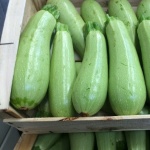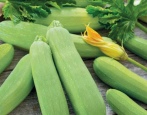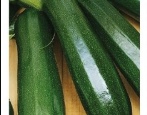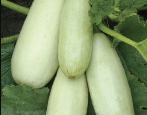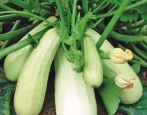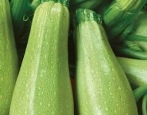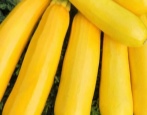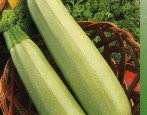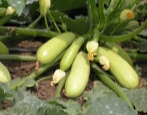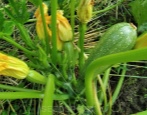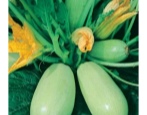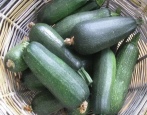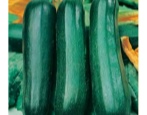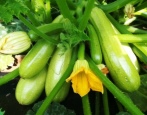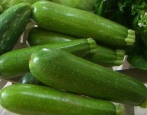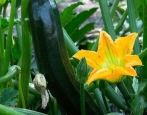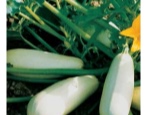
- Authors: Kushnereva V.P., Khimich G.A., Zharova V.P.
- Year of approval: 1999
- Ripening terms: early maturing
- The period from germination to harvest: 40-50 days
- Description of the plant: with 1-2 stitches of the first order
- Leaves: medium-sized, dark green, with a slight white spot (sometimes absent)
- Fruit shape: cylindrical
- Fruit color: dark green with small light dots
- Color of the pulp: yellow
- Pulp (consistency): dense, juicy, crispy, tender
Green-fruited zucchini is a very popular vegetable crop in Europe and especially in their homeland, Italy. This healthy vegetable is also loved in Russia, although it has been grown here for only a few decades. The market offers a wide range of seeds, including the development of domestic breeding, for example, the Pharaoh variety.
Breeding history
This representative of the melons group was bred by the Federal State Budgetary Scientific Institution "Federal Scientific Center for Vegetable Growing", located in the Odintsovo District of the Moscow Region. The institution grew out of the Gribovskaya selection and experimental station created in 1920. The author of the Pharaoh was experienced biologists: head of the VNIISSOK laboratory V.P. Kushnereva and researchers: Khimich G.A., Zharova V.P.
Since 1999, the variety has been in the State Register of Breeding Achievements and is approved for cultivation for commercial production in four regions of the Russian Federation: North-West, Volgo-Vyatka, Central and the Far East. Suitable for growing in the open field and under cover films.
Description of the variety
Pharaoh is an early ripening, cold-resistant, high-yielding variety of zucchini resistant to gray mold fungus with excellent taste and universal purpose. Fruits are medium in size, smooth, cylindrical, dark green.
Characteristics of the appearance of plants and fruits
The plant has the shape of a sparse compact bush, on which 1-2 lashes are formed. The main lash is not very elongated: it reaches a length of 45 to 50 cm. Thick stems and foliage are slightly pubescent. Five-lobed green leaves can be smooth colored or with sparse silvery-white spots.
Fruits in the form of aligned faceted cylinders from 22 to 60 cm long weigh 0.5-1 kg. Average dimensions of a ripe marrow: 40 cm and 0.8 kg. The fruit is covered with a smooth, medium-thick and rather fragile bovine dark green rind with a scattering of pale dots. The pulp is light yellow, with a crispy and juicy texture. Pulp layer thickness: 3-4 cm.
Purpose and taste
The variety is distinguished by an excellent taste: delicate and sweet. At the stage of milky ripeness, zucchini have a minimum amount of seed mass and a delicate peel, they can be eaten completely, without waste: cut or rub into fresh salads, fry, canning.
Older examples can form the basis of a dietary, low-calorie cream soup. Zucchini is stewed and baked, stuffed with all kinds of fillings, harvested for future use, slicing and freezing in the freezer.
Ripening terms
The variety pleases with its early maturity: it takes about 6-7 weeks (40-50 days) from germination to the first harvest. On each plant 4-6 zucchini ripen at the same time. Depending on the region, the harvest is harvested from July to September.
Yield
Pharaoh shows a high yield, ahead of the Beloplodny standard in limiting values (670-1550 centners per hectare against 700-1250 centners). On industrial plantations, the average yield ranges from 60 to 90 tons per hectare.
Indicators of collection of early fruits of milk ripeness: from 540 to 910 c / ha.
On a private plot, 7-9 kg / m² are harvested, when grown under a film - up to 15 kg / m².
The variety is attractive for its good transportability and keeping quality. In a cool cellar, zucchini are stored until early spring.
Growing and care
Pharaoh is distinguished by its unpretentiousness and cold resistance, which makes it possible to grow it in the northern regions with difficult climatic conditions.
When sowing seeds directly into the ground, this operation is carried out in May - early June. The seeds are deepened by 3-5 cm. Less commonly, seedling cultivation is used, with which the seeds are sown in containers at the end of April - beginning of May.
On the garden bed, a 70x70 cm planting scheme is used. Choose a sunny place. Beans, corn, radishes, sunflowers, and nasturtium will become good "neighbors" on the site. Poor zucchini compatibility with potatoes.
The bushes should be regularly and abundantly watered with settled water under the root. Agrotechnical care is simple: hilling, removing leaves with excessive growth of the bush, timely collection of fruits to stimulate the formation of new ovaries.
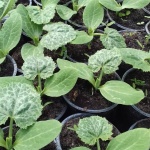

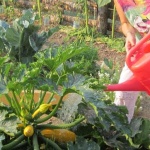
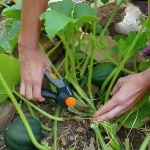
Soil requirements
The variety will feel good on light loam and black soil. The soil should not be too acidic; heavy clay soil is not suitable for zucchini. You should not place a garden bed with zucchini in an area with a close occurrence of groundwater. Poor sandy soils should be enriched with top dressing: compost and magnesium.
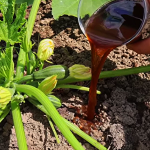
Disease and pest resistance
The variety has good immunity to major infections. It shows the greatest resistance to the fungus of gray rot: only 1% of the plantation is affected.
Regular preventive inspection of plants and spraying with various preparations and natural infusions will protect against pests - spider mites, melon aphids, slugs.
